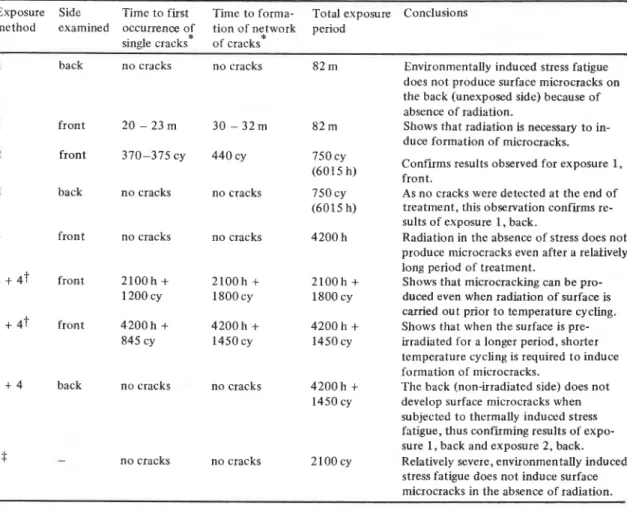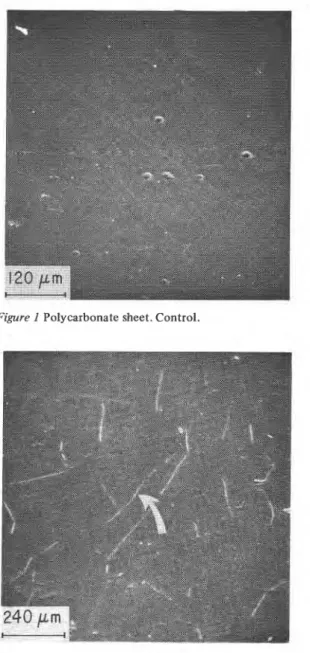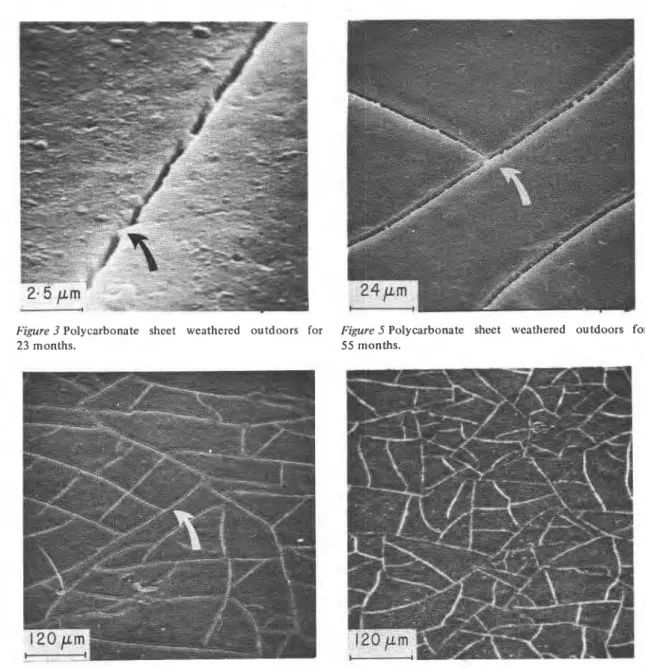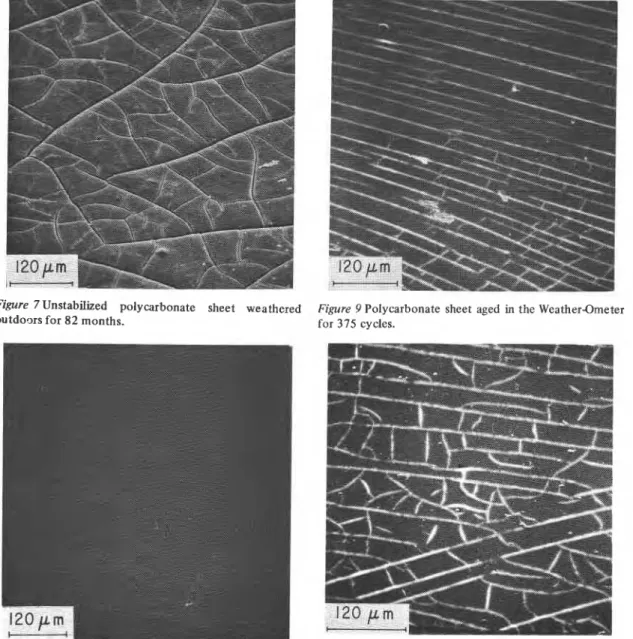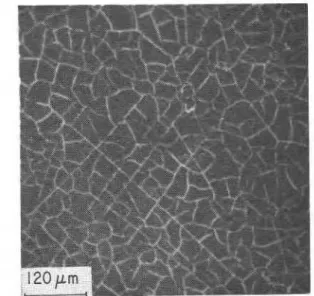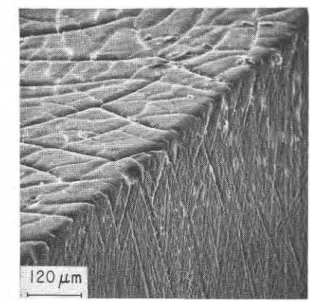Publisher’s version / Version de l'éditeur:
Vous avez des questions? Nous pouvons vous aider. Pour communiquer directement avec un auteur, consultez la première page de la revue dans laquelle son article a été publié afin de trouver ses coordonnées. Si vous n’arrivez pas à les repérer, communiquez avec nous à PublicationsArchive-ArchivesPublications@nrc-cnrc.gc.ca.
Questions? Contact the NRC Publications Archive team at
PublicationsArchive-ArchivesPublications@nrc-cnrc.gc.ca. If you wish to email the authors directly, please see the first page of the publication for their contact information.
https://publications-cnrc.canada.ca/fra/droits
L’accès à ce site Web et l’utilisation de son contenu sont assujettis aux conditions présentées dans le site
LISEZ CES CONDITIONS ATTENTIVEMENT AVANT D’UTILISER CE SITE WEB.
Journal of Materials Science, 11, pp. 1513-1520, 1976
READ THESE TERMS AND CONDITIONS CAREFULLY BEFORE USING THIS WEBSITE. https://nrc-publications.canada.ca/eng/copyright
NRC Publications Archive Record / Notice des Archives des publications du CNRC :
https://nrc-publications.canada.ca/eng/view/object/?id=a4a4929e-1839-48ef-988d-c30595696bfc
https://publications-cnrc.canada.ca/fra/voir/objet/?id=a4a4929e-1839-48ef-988d-c30595696bfc
NRC Publications Archive
Archives des publications du CNRC
This publication could be one of several versions: author’s original, accepted manuscript or the publisher’s version. / La version de cette publication peut être l’une des suivantes : la version prépublication de l’auteur, la version acceptée du manuscrit ou la version de l’éditeur.
For the publisher’s version, please access the DOI link below./ Pour consulter la version de l’éditeur, utilisez le lien DOI ci-dessous.
https://doi.org/10.1007/BF00540886
Access and use of this website and the material on it are subject to the Terms and Conditions set forth at
Surface microcracking induced by weathering of polycarbonate sheet
Blaga, A.; Yamasaki, R. S.
Ser
TH1
N21d
0
;08lational Research
Conseil national
:ouncil Canada
de recherches Canada
BLDG
SURFACE MICROCRACKING INDUCED BY
WEATHERING OF POLYCARBONATE SHEET
4N4
L
yZCD
by A.
Blaga andRS.
YamasakiReprinted from
Journal of Materials Science Vol. 11, 1976
p. 1513 1520
DBR PaperNo. 708
Division of Building Research
BUILnJk'G
RESEARCH
+-
LIBRARY
-
FEE 3 1977
NATIONAL RESEARCH COUNCIL
h
-
1
S O W I R E
Une btude a btb entrepriee
h
la DRB/CNR de l'effet d e troie facteure du milieu-
l a tempbrature, l'humiditb et le rayonne- ment-
ebr l a durabilitb de plaques commercialee exposbee a w intemperieo. Lee rbeultatsl de ltbtude sont dkcrite dans cette communication e t un mbcanieme eat proposb pour l a formation dee microfieeuree en eurface dee plaquee en poly- carbonate danr dee conditions b'expoeition extbrieure.I
J O U R N A L O F M A T E R I A L S S C I E N C E 11 ( 1 9 7 6 ) 1 5 1 3 - 1 5 2 0
Surface microcracking induced by
weathering of polycarbonate sheet
4N4
t
y z E P
A. B L A G A , R.S. Y A M A S A K I
Building Materials Section, National Research Council o f Canada, Division o f Building Research, Ottawa, Ontario, Canada
Polycarbonate sheet subjected t o outdoor weathering for relatively short periods develops
a
network o f surface microcracks on the side exposed t o solar radiation. Artificialweathering and SEM microscopy were used t o illustrate the process of microcrack forma- tion. Microcracking occurs under the influence of light radiation in conjunction with cycling of either temperature and moisture or temperature alone. The use of radiation by itself, or even relatively severe cycling of temperature and humidity without radiation, does not induce microcracking. According t o the proposed mechanism, the resin of the exposed surface undergoes, with weathering, a gradual reduction in strength owing t o a lowering of i t s molecular weight as a result of photochemical degradation. Cyclic varia- tion of temperature and humidity in natural and artificial weathering imposes on the
surface material a type of stress fatigue. Such stress fatigue i s caused by the non-uniform
dimensional changes that result from thermal and moisture content gradients between the surface and the bulk of the resin and from inhomogeneities and defects. When the fatigue limit of the surface material at a microsite becomes lower than the physically induced stresses, the resin cracks.
1. Introduction
Polycarbonate sheeting is used increasingly as shatter-proof glazing material in public and indust- rial buildings because of its very high impact resist- ance and excellent transparency. As it is becoming economically more attractive, polycarbonate is also entering other fields of materials application where it will be exposed to various interior and exterior environments. It is, therefore, essential that its performance in these environments be understood, in particular, its resistance to outdoor weathering.
A relatively new commercial plastic material, polycarbonate, has undergone very few weathering studies [ l , 21. Those that have been done have been concerned only with the photochemical processes of degradation by solar radiation. A number of studies have been carried out that demonstrate the reaction mechanism of photo- chemical degradation of the polycarbonate poly- mer by subjecting it to accelerated weathering
[3] or to irradiation with longwave ultraviolet
light approximating that of natural sunlight [ l
,
4 , 5 ] . This work on the degradation of poly- carbonate in both outdoor and artificial environ- ments has generally been carried out on film material and has covered relatively short periods of time. In all these studies the physical effects of temperature and humidity, two important factors of most environments, have been neglected.
A study has, therefore, been undertaken at
DBRINRC of the effect of three environmental
factors - temperature, humidity, and radiation -
on the durability of commercial polycarbonate sheeting exposed in an outdoor environment. Scanning electron microscopy (SEM) was used to assess changes in surface structure, and examin- ation of the exposed side revealed the formation of a network of surface microcracks after 30 to 32 months. Samples of polycarbonate sheet were then subjected to various artificial weathering treatments in an attempt to reproduce this type of O 1976 Chapman and Hall Ltd. Printed in Great Britain.
TABLE 1 Methods of environmental ageing of polycarbonate sheets Method Ageing conditions
General Details
1 Outdoor weathering at Ottawa (temperate northern climate)
Samples exposed at 45O facing south, with no backing, in accordance with ASTM D1435.
4 h at 100% r.h. and 1 2 0 ~ 7 , water spray on, no radiation; 4 h at 50% r.h. and 55"C, radiation on, water spray off; 3 cycles per day.
R.h. at 50% and panel temperature of 55°C at all times 2 Cyclic variation of temperature, humidity and
radiation (Atlas Xenon Arc Weather-Ometer) 3 Continuous radiation at constant temperature
and humidity (Atlas Xenon Arc Weather- Ometer)
4 Cyclic variation of temperature between - 18 and 25" C
10 min cooling to - 18°C and 10 min warm-up to 25' C
7 h at 100% r.h. and 56OC; 5 h at 25 to 100% r.h. and 1 1 to 56O C; 2 cycles per day
5 Cyclic variation of temperature and humidity (Aminco Climate ~ a b ) *
ore
details are given in [6] Figs. 1 and 2; deionized water at g°C is sprayed on the exposed side of the panel. t ~ h e temperatures are those of the samples.TABLE I1 Data on the formation of surface microcracks in polycarbonate sheet Exposure Side Time to first Time to forma- Total exposure Conclusions method examined occurrence of tion of network period
sinde cracks* of cracks*
back no cracks no cracks Environmentally induced stress fatigue does not produce surface microcracks on the back (unexposed side) because of absence of radiation.
Shows that radiation is necessary to in- duce formation of microcracks. front
front
Confirms results observed for exposure 1, front.
As no cracks were detected at the end of treatment, this observation confirms re- sults of exposure 1 , back.
Radiation in the absence of stress does not produce microcracks even after a relafively long period of treatment.
Shows that microcracking can be pro- duced even when radiation of surface is carried out prior to temperature cycling. Shows that when the surface is pre- irradiated for a longer period, shorter temperature cycling is required to induce formation of microcracks.
The back (non-irradiated side) does not develop surface microcracks when subjected to thermally induced stress fatigue, thus confirming results of expo- sure 1, back and exposure 2, back. Relatively severe, environmentally induced stress fatigue does not induce surface microcracks in the absence of radiation. back no cracks no cracks
front no cracks no cracks
front
front
back no cracks no cracks
n o cracks no cracks
* ~ i m e of occurrence of surface microcracks is given in months (m), cycles (cy) or hours (h).
t ~ h e s e samples were subjected to continuous radiation for 2100 and 4200 h, respectively, prior to subjecting them to temperature cycling.
t l n this method both sides are subjected to the same exposure. 1514
failure and thus gain insight into the process of surface deterioration.
In this paper the results of the study are de- scribed and a mechanism proposed for the forma- tion of surface microcracks in polycarbonate sheeting under the conditions of the outdoor exposure. An understanding of the process of surface deterioration and the role of the environ- mental factors involved should permit develop- ment of more adequate methods of assessing the durability of polycarbonate and possibly other thermoplastic materials.
2.
Experimental2.1.
Materials and methods of ageiig Commercial glazing sheet (3.0 mm thick) of bisphenol A polycarbonate was used in this study. Although most of the samples were of stabilized polycarbonate, unstabilized sheet was also used for- ~
comparison in the outdoor weathering. Initially, sheets of polycarbonate were exposed outdoors at a weathering site at Ottawa, but samples were sub- sequently exposed to various accelerated weather- ing treatments. Details of both outdoor exposure and methods of accelerated ageing are given in Table I.
2.2.
Examination of surface microcracking by scanning electron microscopy The formation of surface microcracks was followed by a Stereoscan scanning electron microscope operated at 20kV and a tilt angle of 45". Speci- mens were coated first with carbon and then with gold t o prevent surface charging.3.
Discussion of resultsThe formation of surface microcracks in poly- carbonate sheets and their characteristic features at various stages of environmental ageing treat- ments are illustrated by SEM micrographs in Figs. 1 to 14. Unless otherwise specified, the SEM micro- graphs refer to stabilized polycarbonate samples. Table I1 summarizes the results and conclusions of the study.
3.1.
Surface microcracking during outdoor weatheringPolycarbonate sheets weathered outdoors at Ottawa (Table I, method 1) developed surface microcracks on the side exposed to solar radiation. Figs. 2 and 3 illustrate the incipient stage of sur- face microcracking that occurred after 20 to 23
Figure I Polycarbonate sheet. Control.
Figure 2 Polycarbonate sheet weathered outdoors for 23 months.
months of exposure. The very narrow (0.1 to 0.2
pm in width), randomly-oriented initial cracks
propagate slowly with ageing and intersect to form a network. This network of relatively shallow cracks divides the surface of the sheet into pre- dominantly triangular and four-sided polygons (Figs. 4 , 6 and 7).
At -relatively low magnification the cracks appear as bright lines because of electrical charging (Figs. 2 and 4). At higher magnification, however, they display the usual characteristics of cracks (Figs. 3 and 5) and show none of the features of crazes as this term is currently understood [7].
Figure 3 Polycarbonate sheet weathered outdoors for 23 months.
Figure 5 Polycarbonate sheet weathered outdoors for
55 months.
Figure 4 Polycarbonate sheet weathered outdoors for 5 5 months.
The areas confined between the intersecting cracks decrease with weathering because the surface resin layers continue to fracture, forming new cracks. Figs. 6 and 7 show the surface of the exposed side of stabilized and unstabilized sheets weathered outdoors for 82 months. As expected, the surface microcracks of the unstabilized sheet are deeper and wider than those of the sheet made from stabilized material; their number per unit area of surface (density of cracks) is also greater, as evi- denced by the smaller area of the polygons formed by the cracks.
1516
Figure 6 Polycarbonate sheet weathered outdoors for
82 months.
The back of the polycarbonate sheet, which is exposed to essentially the same environmental conditions except for the action of radiation, did not show any evidence of surface microcracks (Fig. 8), indicating that radiation is necessary for their formation.
3.2.
Accelerated weathering with cycling of radiation, humidity and tempera- tu reExposure of polycarbonate sheets to alternate cycles of radiation and water spray in the Xenon
Figure 7Unstabilized polycarbonate sheet weathered Figure 9 Polycarbonate sheet aged in the Weather-Ometer o u t d o ~ s for 82 months. for 375 cycles.
Figure 8 Polycarbonate sheet (back side) weathered out- Figure I OPolycarbonate sheet aged in the Weatherameter
1 doors for 82 months. for 440 cycles.
Arc
weather- meter* (Table I, method 2) resulted
in the formation of surface microcracks in the exposed (front) side of the samples. The initial cracks were usually parallel (Fig. 9), unidirectional and occurred after 370 to 375 cycles (each lasting 8h). Secondary, mostly parallel, cracks subse- quently formed, intersecting the initial cracks
(Figs. 9 to 11) t o produce a network.
The polygons formed by microcracks induced by Weather-Ometer ageing were generally fairly regular in shape (usually rectangular), perhaps
because of the good reproducibility of cycles and relatively uniform change in the environmental conditions at the sample during any given cycle. This is in contrast to the irregular polygons formed during outdoor weathering, where the environ- mental conditions are quite variable during a cycle and from one cycle to another.
As for outdoor weathering, the density of the cracks increased with ageing and the back (unex- posed) of the sheet did not undergo surface micro- cracking.
Figure 11 Polycarbonate sheet aged in the Weather- Orneter for 750 cycles.
3.3.
Accelerated weathering with contin- uous radiation and constant tempera- ture and humidityContinuous radiation at 55°C (sample tempera- ture) and 50% r.h. (Table I, method 3) did not produce surface microcracking in polycarbonate sheet even after 4200 h (Table 11, method 3), a period equivalent to 8400 h of intermittent radia- tion with temperature and humidity cycling (Table
I, method 2).
3.4.
Thermal cycling of pre-irradiated polycarbonate sheetWhen polycarbonate sheet, pre-irradiated as de- scribed in the previous section (Table I, method 3) was subjected to temperature cycling between - 18 and 25"
c
(Table I, method 4) surface micro- cracks were produced on the pre-irradiated side only (Table 11, methods 3 and 4). They were much finer than those produced in either outdoor weathering or Weather-Ometer ageing. Thermal cycling did not induce microcracking in the non- irradiated (control) sheet.The sheet pre-irradiated for 2100h developed incipient microcracks after about 1200 tempera- ture cycles and a network of very fine cracks after about 1800 cycles (Figs. 12 and 13). The density of the cracks was very high, as shown in these micrographs of relatively high magnification. The polycarbonate sheet pre-irradiated for 4200 h required only 845 temperature cycles to develop incipient microcracks. A full network of surface microcracks formed after about 1450 cycles.
Figure 12 Polycarbonate sheet subjected to 2100 h continuous radiation in the Weatherameter and sub- sequently to 1800 temperature cycles.
Figure 13 Polycarbonate sheet subjected t o 2100 h continuous radiation in the Weatherameter and sub- sequently to 1800 temperature cycles.
3.5. Exposure to variable temperature and humidity without radiation
Polycarbonate sheet subjected to cycles of humi- dity and temperature (Table 1, method 5) did not develop surface microcracks (Table 11, method 5) even after 2100 cycles (approximately 3 yr). Cycling of temperature and humidity induces localized, alternating microstresses between the surface resin layer and the bulk of the material, and at flaws and inhomogeneous points in the sur- face, causing a type of stress fatigue. These obser-
vations corroborate those presented earlier and demonstrate that surface microcracks in a sheet of polycarbonate are not caused by environment- ally induced stresses alone even if they are relatively severe; the degradative action of radiation is also required.
4.
Mechanism of surface microcrackingIn outdoor weathering and in most of the ageing treatments described, the polymeric material in the surface region of the sheet undergoes dimen- sional changes as a result of cyclic variations in temperature and humidity. Cyclic changes of temperature result in alternating volume expan- sions and contractions of the material; cyclic variations of' humidity cause absorption and desorption of moisture, and this in turn results in alternating swelling and shrinking. Dimensional changes induced by both temperature and moisture may be in the same or in opposite directions, depending upon the exposure conditions to which the material has been subjected.
For example, during very hot, humid summer days, plastic sheets exposed outdoors undergo thermal expansion at the same time as swelling caused by water absorption. During hot, dry periods they undergo thermal expansion, but moisture-induced volume change may be in the opposite direction because of water desorption. Similar volume change relations can occur during artificial exposure (Table I, methods 2 and 4).
The average magnitude and rate of volume change could be relatively large and variable, depending on the state of the plastic and the conditions imposed. For artificial weathering exposure, thermally induced volume change was estimated to be 0.86% for a temperature change of 43°C and cubic thermal coefficient of expan- sion of 20
x
~ O - ~ ~ C - ' . The rates of volume change were uniform for a given imposed cycle, but varied with conditions of exposure. In out- door weathering, thermally induced volume changes can be irregular with respect to both value and rate because of fluctuations in the weather.Although the equilibrium amount of water absorbed is relatively low (0.45%, McBain quartz balance, 100% r.h., 23" C), the volume changes induced by moisture may be significant, especially when these volume changes are in the same direc- tion as those induced thermally. In both artificial and outdoor weathering the amount and rate of water absorption will change with time as a result
of surface cracking, formation of hydrophilic groups by hydrolysis, and reduction in molecular weight. In particular, gradual reduction in mole- cular weight will result in an increasing number of chain ends that will augment the number of sub- microscopic voids. An increased number of voids will cause absorption of larger amounts of water, probably at higher rates of absorption.
Owing to gradients in temperature and moisture content in the plastic and to the presence of in- homogeneities and flaws [ 7 ] , the cyclic dimen- sional changes that occur are not uniform with depth nor are they uniform at the same depth beneath the surface. They cause a variable, non- uniform stress that exerts a type of stress fatigue on the material. Thermally or moisture-induced stresses can be relatively large, depending on con- ditions. For example, shortly after the change from radiation to water spray (Weather-Ometer exposure, Table I, method 2) the topmost layer will be at approximately 9"C, the temperature of the water spray; at the same time, because of the low thermal conductivity of the material, the layer at 1 0 to 2 0 p m depth will still be at 55°C (panel temperature during radiation). Consequently, the resin in the top layer tends to contract, but it is restrained by the underlying layers, which are still in the expanded state. This produces tensile stresses in the top layers. If, for simplicity, uniform temperature and stress in the surface plane are assumed, the difference in thermal stresses, Ao,
between the top layer and the layer at 10 to 20 pm
depth can be estimated using the following equa- tion:
where E is the modulus of elasticity, cu the coeffic-
ient of thermal expansion, and AT the difference in temperature. The estimated difference in ther- mal stress was 7.3
x
106pa (1060 psi), using 2.41x
l o 9 Pa, 6.6x
IO-~"C-' and 4 6 ' ~ for E,cu and AT, respectively.
Initially, the polymeric material in the surface has a stress-fatigue limit (maximum stress below which fracture by fatigue never occurs) higher than the environmentally induced stresses and thus undergoes repeated reversible deformation without fracture. Owing to the action of the ultraviolet portion of solar radiation, the material of the exposed surface layers undergoes a gradual decrease in molecular weight [8] by a process of photo-oxidative chain scission [9]
.
This decrease,which does not occur in the bulk material nor in the surface layers of the side not exposed t o solar radiation, is in proportion to the amount of irradia- tion by ultraviolet light.
A decrease in molecular weight causes a lowering of the total attractive forces between adjacent polymer chains, and this, in turn, lowers the resist- ance of the resin to fracture. When the fatigue limit at a given site becomes lower than the environmentally induced differential stresses, fracture of the surface resin occurs, producing microcracks. Because of gradients in the stresses involved, the cracks grow from the surface in- wards and are V-shaped, with the median plane approximately perpendicular to the sheet; the cracks are limited to the exposed surface region (Fig. 14).
Figure 14 Cross-section o f polycarbonate (unstabilized) sheet weathered outdoors for 7 7 months.
5. Conclusions
Polycarbonate sheet subjected to outdoor weather- ing for a relatively short period (30 to 32 months) develops a network of surface microcracks on the side exposed to solar radiation. Artificial weather- ing studies show that microcracks are formed under the influence of light radiation and cycling of either temperature and moisture or temperature alone. The use of radiation by itself, or even severe cycling of temperature and humidity without radiation, does not produce microcracking.
It is believed that cyclic variation of tempera- ture and humidity in natural and artificial weather- ing imposes a type of stress fatigue on the material. This physically induced stress fatigue is caused by the non-uniform dimensional changes that result from thermal and moisture content grad- ients between the surface and the bulk resin and from inhomogeneities and defects inherent in the material. With weathering, the resin of the exposed surface undergoes gradual photochemical degrada- tion that reduces its strength. When the fatigue limit at a microsite becomes lower than the physically induced stresses, the resin undergoes fracture to produce microcracks.
The cracks grow from the surface inward and are V-shaped, indicating that the stresses involved have a gradient. Although the ultraviolet-stabilized polycarbonate sheet showed considerably less severe degradation than the unstabilized sheet, results described here demonstrate that protection against the effects of radiation is still not adequate. Acknowledgements
The authors wish t o thank E.G. Quinn for coating the specimens for SEM examination and R.L. Dubois for operating the Weather-Ometer and for looking after the exposed samples. This paper is a contribution from the Division of Building Re- search, National Research Council of Canada, and is published with the approval of the Director of the Division.
References
1 . S. T A H A R A , Chem. High Polymers (Japan) 2 3 ( 1 9 6 6 ) 3 0 3 . . .
D. WEICHERT.and K. BUHLER, Plaste u n d Kautsch 1 2 ( 1 9 6 5 ) 4 .
M . T O M I K A W A , Chem. High Polymers (Japan) 20
( 1 9 6 3 ) 1 4 5 .
T . J . G E D E M E R , A p p l . Spectroscopy 19 ( 1 9 6 5 ) 1 4 1 . B. D. GESNER and P . G . KELLEHER, J. Appl. Polymer Sci. 13 ( 1 9 6 9 ) 2 1 8 3 .
A . B L A G A and R.S. Y A M A S A K I , J. Mater. Sci. 8
( 1 9 7 3 ) 1 3 3 1 .
0 . K. SPUR and W . D. NIEGISH, J. A p p l . Polymer Sci. 6 ( 1 9 6 2 ) 5 8 5 .
R . S. Y A M A S A M and A . B L A G A , t o b e published. A . DAVIS and J . H. G O L D E N , J. Macromol. Sci. Rev. Macromol. Chem. C 3 ( 1 9 6 9 ) 4 9 .
Received 27 October 1975 and accepted 16 February 1 9 7 6 .
Thie publication i r being d i r t r i b u t e d by the Divieion of Building R e e e a r c h of the National Remearch Council of Canada. I t ehould not be reproduced i n whole o r in p a r t without p e r m i r r i o n of the original publieher. The Di- virion would b e glad to b e of a r r i r t a n c e in obtaining much p e r m i r r i o n .
Publfcationr of the Diviaion m a y b e obtained by m a i l - ing the a p p r o p r i a t e r e m i t t a n c e ( a Bank, E x p r e a r , o r P o e t Office Money O r d e r , o r a cheque, m a d e payable to the R e c e i v e r G e n e r a l of Canada, c r e d i t NRC) t o the National R e s e a r c h Council of Canada, Ottawa. K1A OR6. Stamps a r e not acceptable.
A l i e t of a l l publications of the Division i s available and m a y b e obtained f r o m the Publicatione Section, Division of Building Research, National R e s e a r t h Council of Canada, Ottawa. KIA OR 6.
